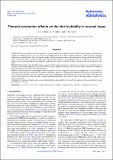Files in this item
Thermal conduction effects on the kink instability in coronal loops
Item metadata
| dc.contributor.author | Botha, G. J. J. | |
| dc.contributor.author | Arber, T. D. | |
| dc.contributor.author | Hood, A. W. | |
| dc.date.accessioned | 2014-01-16T10:31:04Z | |
| dc.date.available | 2014-01-16T10:31:04Z | |
| dc.date.issued | 2011-01 | |
| dc.identifier | 6038476 | |
| dc.identifier | 562063ee-cb24-4e2b-b714-596c7d08e9cc | |
| dc.identifier | 000285193700130 | |
| dc.identifier | 78649954674 | |
| dc.identifier.citation | Botha , G J J , Arber , T D & Hood , A W 2011 , ' Thermal conduction effects on the kink instability in coronal loops ' , Astronomy & Astrophysics , vol. 525 , A96 . https://doi.org/10.1051/0004-6361/201015534 | en |
| dc.identifier.issn | 0004-6361 | |
| dc.identifier.other | ORCID: /0000-0003-2620-2068/work/58055151 | |
| dc.identifier.uri | https://hdl.handle.net/10023/4373 | |
| dc.description.abstract | Context. Heating of the solar corona by nanoflares, which are small transient events in which stored magnetic energy is dissipated by magnetic reconnection, may occur as the result of the nonlinear phase of the kink instability (Hood et al. 2009). Because of the high temperatures reached through these reconnection events, thermal conduction cannot be ignored in the evolution of the kink instability. Aims. To study the effect of thermal conduction on the nonlinear evolution of the kink instability of a coronal loop. To assess the efficiency of loop heating and the role of thermal conduction, both during the kink instability and for the long time evolution of the loop. Methods. Numerically solve the 3D nonlinear magnetohydrodynamic equations to simulate the evolution of a coronal loop that is initially in an unstable equilibrium. The initial state has zero net current. A comparison is made of the time evolution of the loop with thermal conduction and without thermal conduction. Results. Thermal conduction along magnetic field lines reduces the local temperature. This leads to temperatures that are an order of magnitude lower than those obtained in the absence of thermal conductivity. Consequently, different spectral lines are activated with and without the inclusion of thermal conduction, which have consequences for observations of solar corona loops. The conduction process is also important on the timescale of the fast magnetohydrodynamic phenomena. It reduces the kinetic energy released by an order of magnitude. Conclusions. Thermal conduction plays an essential role in the kink instability of coronal loops and cannot be ignored in the forward modelling of such loops. | |
| dc.format.extent | 11 | |
| dc.format.extent | 2086623 | |
| dc.language.iso | eng | |
| dc.relation.ispartof | Astronomy & Astrophysics | en |
| dc.subject | Sun | en |
| dc.subject | Corona | en |
| dc.subject | Magnetohydrodynamics (MHD) | en |
| dc.subject | Magnetic fields | en |
| dc.subject | Plasmas | en |
| dc.subject | Magnetic reconnection | en |
| dc.subject | Flares | en |
| dc.subject | QB Astronomy | en |
| dc.subject.lcc | QB | en |
| dc.title | Thermal conduction effects on the kink instability in coronal loops | en |
| dc.type | Journal article | en |
| dc.contributor.institution | University of St Andrews. Applied Mathematics | en |
| dc.identifier.doi | https://doi.org/10.1051/0004-6361/201015534 | |
| dc.description.status | Peer reviewed | en |
This item appears in the following Collection(s)
Items in the St Andrews Research Repository are protected by copyright, with all rights reserved, unless otherwise indicated.

